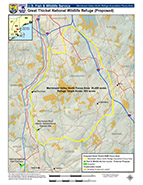See a fact sheet with highlights of the proposal [PDF]
From US Fish and Wildlife Service:
Over the past century, many shrublands and young forests across the Northeast have been cleared for development or have grown into mature forests. As this habitat has disappeared from much of the landscape, the populations of more than 65 songbirds, mammals, reptiles, pollinators, and other wildlife that depend on it have fallen alarmingly.
The U.S. Fish and Wildlife Service, state wildlife agencies, private landowners and dozens of conservation organizations have responded to this urgency by restoring and protecting shrublands and young forest throughout the landscape of New England and New York. Despite significant progress, conservationists have determined that more permanently protected and managed land is needed to restore wildlife populations and return balance to northeast woodlands.
To address this need, the Service is proposing to establish Great Thicket National Wildlife Refuge – dedicated to managing shrubland habitat. Through coordination with conservation partners, the Service has determined that areas of Strafford, Rockingham and Hillsborough counties could provide important habitat for shrubland wildlife and help connect existing conservation areas. They include parts of the state’s most developed sections, bordered by Nashua, Manchester and Derry, and near the Seacoast.
“We’ve had incredible success in restoring New England’s only native rabbit and its habitat. Yet our work is far from done,” said Rick Jacobson, New England Cottontail Executive Committee chair and Connecticut Department of Environmental and Energy Protection Wildlife Division Director. “We need to preserve and manage more land as shrublands and young forest to continue to advance conservation for the cottontail. But this isn’t just about a rabbit. It’s about American woodcock, ruffed grouse, golden-winged warblers, monarch butterflies and a whole suite of wildlife that depend on this habitat.”
Other wildlife that would benefit include Blanding’s turtle, whippoorwill, Karner blue butterflies and blue-winged warblers.
A land protection plan and environmental assessment is an early step in a public process that examines whether the Service can establish a national wildlife refuge. The draft Great Thicket National Wildlife Refuge Land Protection Plan explains the need for land conservation, complements existing conservation activities, and describes each of the 10 focus areas across the six states. At this stage in the process, the Service invites public comment on the draft plan, which will shape the final decision.
If the plan is approved after the public comment period, the agency could begin working with interested landowners to conserve up to 1,500 acres across three New Hampshire focus areas through a combination of purchasing conservation easements and buying land, from willing sellers only. Current refuge staff would manage all acquired lands using existing resources. More than 6,900 acres in these three areas are already managed for wildlife through easements or ownership by organizations or local, state and federal agencies, but only a small portion of these are managed as young forest or shrubland.
This process would take decades, as the Service works strictly with willing sellers only and depends on funding availability to make purchases. Lands within an acquisition boundary would not become part of the refuge unless their owners sell or donate them to the Service; the boundary has no impact on property use or who an owner can choose to sell to.
Local conservation organizations, private landowners, New Hampshire Fish and Game Department, companies including Stonyfield Farm, and USDA-Natural Resources Conservation Service are already restoring young forest and shrubland habitat within the southern New Hampshire focus areas, usually by cutting trees and older shrubs to promote the regrowth of dense thickets.
The National Wildlife Refuge System is the largest network of lands in the nation dedicated to wildlife conservation, with 563 national wildlife refuges – at least one refuge in every state – covering more than 150 million acres. A hundred years in the making, the refuge system is a network of habitats that benefits wildlife, provides unparalleled outdoor experiences for all Americans, and protects a healthy environment. Wildlife refuges provide habitat for more than 2,100 types of birds, mammals, reptiles, amphibians and fish, including more than 380 threatened or endangered plants or animals. Each year, millions of migrating birds use refuges as stepping stones while they fly thousands of miles between their summer and winter homes.
The Service will accept comments through March 4, 2016. Email northeastplanning@fws.gov with “Great Thicket LPP” in the subject line. Mail to Beth Goldstein, Natural Resources Planner, U.S. Fish and Wildlife Service, 300 Westgate Center Drive, Hadley, MA 01035-9589
Fax to 413-253-8480
The draft plan and all related documents are available at www.fws.gov/northeast/refuges/


 Return to the Concord Monitor
Return to the Concord Monitor